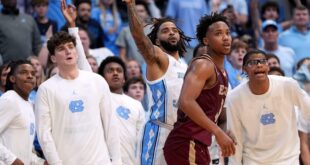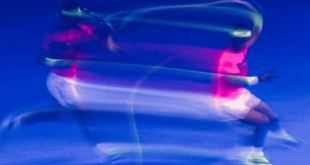ASHBURN, Va. — Kliff Kingsbury embraces the virtual reality simulation Jayden Daniels credits with advancing his quarterback skills, even if the technology initially sent him in the wrong direction.
“The first time I put it on, I backed into the wall,” said Kingsbury, the Washington Commanders’ offensive coordinator and former Texas Tech quarterback. “It felt like the (pass) rush was coming.”
The former Arizona Cardinals head coach spent his one-year absence from the pro ranks determined to seek new approaches should he return. Playing in Mike Leach’s “air raid” system with the Red Raiders from 2000 to 2002 meant Kingsbury quarterbacked one of football’s recent offensive evolutions.
He isn’t about to stunt the latest.
“I’m all in on it,” Kingsbury said of the VR platform. “I mean, it’s an unbelievable technology.”
Six weeks into his rookie season, Daniels is the talk of the league and part of nascent MVP conversations. The Commanders, led by a highly efficient offense tied for second at 29.7 points per game, sport a buzzy 4-2 record entering Sunday’s home game against the Carolina Panthers.
Perhaps the only thing quicker than Daniels’ accelerated growth is the speed at which he sets the VR simulation. That would be the highest possible setting.
“It moves faster within the VR than actual human beings,” Daniels said before Washington opened the 2024 season. “Once you get out there, everything slows down. I know this is coming. I’ve seen this before, (and) it moved more than 20 times faster in VR.”
Jayden Daniels works with virtual reality every morning like a “flight simulator for QBs”@tracywolfson has more 🎤 pic.twitter.com/LmScO2SBt4
— NFL on CBS 🏈 (@NFLonCBS) October 13, 2024
The simulation from the German company Cognilize arrived on the LSU campus ahead of Daniels’ final season. The dual-threat quarterback became an immediate disciple of the immersive technology initially designed for top-shelf soccer players to get extra reps beyond practice without additional wear and tear. Fast forward, the quarterback with mid- to late-round draft projections entering 2023 became a star.
Daniels dazzled with 50 touchdowns — 40 passing, 10 rushing — 3,812 passing yards and 4,946 total yards from scrimmage with just four interceptions en route to winning the Heisman Trophy. He had not passed for 3,000 yards or more than 17 touchdowns in any of his previous four seasons at LSU or Arizona State.
When LSU’s staffers lowered the VR’s pace to game speed, “It felt like slow motion,” Daniels said.
That hasn’t changed, as shown by his pinpoint accuracy — Daniels’ 75.3 completion percentage leads the NFL — and Matrix-like movements around defenders. He ranks fourth among quarterbacks in total yards (1,726) and has accounted for 10 touchdowns, six through the air.

GO DEEPER
For Jayden Daniels’ Commanders, a loss in Baltimore, but not a setback
Regardless of results, not every coach grows with his or her sport or accepts new and different approaches. Some, stuck in their ways, are willing to rise and fall with their methods. The Commanders staff under coach Dan Quinn keeps an open mind about innovations, how they can apply to multiple positions and whatever is coming around the bend.
“It’s one of the fun parts of coaching,” Quinn said. “Nothing really stays the same, and there’s things that evolve and move forward.”
Washington targeted Daniels early in the pre-draft cycle, meaning Kingsbury had time to start formulating a plan for the Commanders’ next quarterback hope. Early meetings after the draft, where Washington made Daniels the No. 2 pick, led the coordinator to make the VR simulation a “huge component” of his weekly process.
“It’s a unique technology, and it’s definitely for the quarterbacks,” Kingsbury said. “I think it is more effective than them just watching the film. They’re going through their reads, they’re going through their progressions, they’re seeing it.”
Daniels is also simultaneously hearing Kingsbury. The coordinator tweaked his daily schedule to spend 45 to 60 minutes narrating the weekly plays into a recorder. Kingsbury’s voice is the soundtrack for those VR sessions.
“(Pilots) don’t go get trained in real planes. They do their flight simulators. … (Jayden) has that thing on all the time. He can see our reads and routes and hears my voice in it. It’s as real as you can (get to) getting game reps, and your mind doesn’t know the difference,” Kingsbury said. “Your mind thinks you’re doing it.”
Soon after the draft, the organization purchased the VR simulation for its quarterbacks. Marcus Mariota, the Commanders’ backup and a former NFL starter, finds the modern application “amazing” in helping quarterbacks develop comfort within an offense and recognize patterns.
“I believe defenses are patterns,” Mariota said. “Recognizing them quickly is important, and (the VR) seems to help Jayden with that.”

GO DEEPER
How a ‘flight simulator’ for QBs made Jayden Daniels even scarier on field
Confidence throwing into coverage and “having a feel for space” is part of Daniels’ college-to-NFL adjustment and another way the simulation aids improvement.
“You got to throw some guys open,” Daniels said. “There’s (defenders) that have played in this league a long time that are very savvy and know what’s coming, all the patterning and stuff like that. You got to make some tight-window throws. So that’s what you got to do in this league.”
The experience isn’t only about after the snap. Simulations allow the quarterback to move in the pocket and use the entire field. Details of road stadiums, including the location of play clocks, enable the user to experience the whole scene before stepping inside.
Less sophisticated versions of the VR product existed in the past. Mariota received a sneak peek at a simulator run by Stanford years ago. The 2014 Heisman winner recalled the process using clips from game tape that couldn’t come close to replicating gamelike situations.
Nine-year veteran Jeff Driskel “played around” with VR tech as a rookie. As a “visual learner,” Washington’s emergency third-string quarterback recognizes the massive improvements from then to now. It’s personalized each game “based on what we think they’ll do on defense and what we’ll do on offense.”
Quinn, 54, leans into the teaching aspect of his job and assembled his staff accordingly. Seeing this advancement of technology lights up the “lifelong learner.” Now backup quarterbacks such as rookie Sam Hartman, who rarely gets significant practice time within the team’s offense, have a tool to help them learn.
“Reps are always few and far between for everybody, especially at the level and pace we’re going,” Hartman said. “The goal for quarterbacks is getting reps and seeing every play a million times. (VR) really helps.”

Free, daily NFL updates direct to your inbox.
Free, daily NFL updates direct to your inbox.
Hartman, a member of Washington’s practice squad, has played video games wearing the Oculus headset but gets motion sickness with all the actual movement. The football simulation does not require running around.
“If I had Jayden’s speed, I’d run around a little more,” cracked Hartman, an undrafted free agent out of Notre Dame.
Mariota and Driskel said there is no telling how much assistance Daniels receives from the simulation or how he would execute under center without VR. They know that more reps lead to honing instincts. When instincts take over in real games, success often follows.
Daniels suffered a concussion in practice last year the week before LSU faced SEC-rival Florida. The injury kept him from the physical but not the mental parts of practice. He then delivered the signature performance of his college career with 372 passing yards, 234 rushing and five combined touchdowns in the 52-35 victory.
“That’s where the VR helped a lot,” Daniels said.
For now, only Washington’s quarterbacks have access to the groundbreaking technology. When simulations are available for others to trick their minds, the Commanders coaches won’t be afraid to embrace whatever scenarios come their way. The one with Daniels has created quite a nice reality.
(Illustration: Meech Robinson / The Athletic; photos: Patrick Smith, Michael Reaves, Michael Zagaris / Getty Images)
 meganwoolsey Home
meganwoolsey Home



